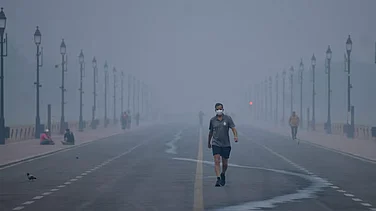FOR 3,500 days, it had been taken for granted. Hundreds of thousands of men, women and children had walked into it, waited in it, and then departed for places, near and far, smug in the belief that nothing but nothing could happen to them in such an impregnable structure.
It took a "kitchen fire" on October 29 for the imposing Airbus Departure Terminal at Delhis domestic airport to show how misplaced that belief was. Beneath the ashes, glass shards and mangled metal was a message: fly on a wing and a prayer, not just in the air but on the ground as well.
Fortunately, no lives were lost because the blaze broke around 3.30 am, before early fliers checked in. And because the ceiling of the terminal collapsed four hours later, when the Towering Inferno had been sealed off. All planes parked in the nearby hangars and runways, too, were safe.
But the scale of the destruction, estimated at Rs 12 crore, is a grim reminder of the waferthin edifice our wondrous structures stand on. The terminal, built in the mid-80s, was reputed to be one of Indias best and was being used by Indian Airlines.
Airport Director Harbans Kumar blames the devastation on the kitchen of the Maurya Sheraton restaurant in the terminal. Other aviation officials, too, parrot the line that the spark became a fire and spread rapidly through the air-conditioning (AC) ducts and electric cablescomputer screens were the first to burstby which time it had become uncontrollable.
But restaurant authorities refute the contention. "Our staff saw smoke from the duct and reported it to the duty manager," says Sheraton spokesperson Shona Adhikari. "Our kitchen is intact. The refrigerators, the ovens, even the 32 LPG cylinders which were in there, are all safe." Airport sources, however, claim the cylinders were shifted out soon after the fire started.
The blaze has been sourced to the kitchen because a fire alarm close to the restaurant was the first to go off. But independent airport sources say it is unlikely that a kitchen fire could have wrought such damage: "It was probably a short circuit. There is no way a fire in the kitchen could have grown so big as to travel several metres in AC ducts. There were lots of inflammable material." Either way, the manner in which the fire, fanned by early morning high velocity winds, ripped through the terminal for four hoursthe steel girders were bent out of shape; bricks and stone were guttedand the failure to smother it for hours is reason enough to wonder if airports are built properly and equipped sufficiently for fire-safety. Computerised check-in counters, telecom lines, furniture, X-ray machines, conveyor belts, cathode ray tubes, electronic information boards, bookshops, snack bars and the airport bank were all destroyed. Fire-resistant material too wasnt spared. "There was probably too much combustible material," says aviation expert Hormuz P. Mama.
The ceiling of the terminal collapsed soon after the fire had been brought under control, bringing down the steel girders. The plywood and plastic used for the false ceiling were burnt and the concrete collapsed under the weight of the girders. Airport authorities have still not refuted press reports that material of inferior quality was used.
Meanwhile, a four-member committee has been set up under Delhi Fire Officer S.K. Dheri to investigate the cause of the blaze, the reasons for its spread, and the availibility, adequacy and utilisation of fire detection and extinguishing systems.
And Union Minister for Civil Aviation C.M. Ibrahim is making the usual noises: "Weve asked all airports to do a thorough review of the facilities." But the fact that it took 45 fire tenders to smother the Delhi blaze raises disturbing questions. All airports are built the same way, says Mama.
Aviation experts say there is no way the Delhi terminal can be salvaged; it will have to be built all over again, at much expense. It might not be a big price to pay. For, having spent crores on flight safety, the least the nation could do is ensure safety on the ground. "The rest," as a Calcutta Airport officer says, "is not in our hands."






















